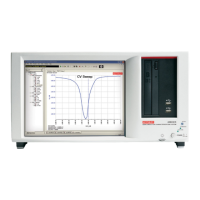4200-900-01 Rev. K / February 2017 Return to Section Topics 3-155
Model 4200-SCS User’s Manual Section 3: Common Device Characterization Tests
Voltage levels do not match expected values
If the voltage at the DUT terminal is not the expected level, please check the
following:
1. The pulse channel is a 50 Ω output and expects a 50 Ω DUT terminal impedance. For a
gate, or other high impedance (>1 k
Ω) terminal, the voltage at the terminal will be twice (2x)
the value specified. For example, setting PulseVoltage = 2 will result in a 4 V level at the
DUT gate. See the Reference manual, Load Line Effect Compensation: Coping with the
Load Line Effect, page 11-20 for additional details about the effect of the DUT impedance on
the pulse level.
2. If the DUT terminal is the drain, alternate manual methods are appropriate. The most
common method for determining the pulse voltage level on the drain is to use an
oscilloscope with the scope input impedance set to 1 M
Ω.
a) Ensure that the gate voltage level meets the desired value before setting other volt-
age levels.
b) Modify the PulseVoltage until the level matched the desired level.
The drain voltage level is a function of the drain-source impedance, which is largely
determined by the gate voltage.
How to perform Charge Pumping
Charge Pumping is a useful technique for understanding gate stack behavior.
Charge Pumping characterizes interface and charge-trapping phenomena. The
change in the CP results can be used to determine the amount of degradation
caused by typical reliability test methods, employing either DC or pulsed stress.
The 4200-SCS provides pre-configured tests to perform Charge Pumping. These
tests are included in the KITE project plan for Charge Pumping.
The User Library for Charge Pumping is also provided in Reference manual,
chargepumping user library, page 16-124. You can use the chargepumping User
Library and an appropriate User Module to create a new UTM (test) in a project
plan.

